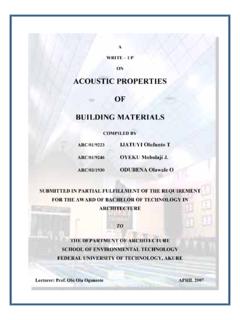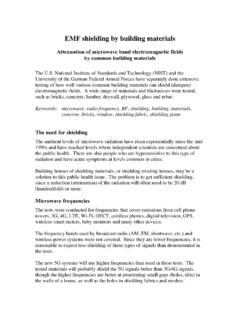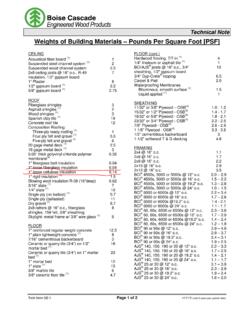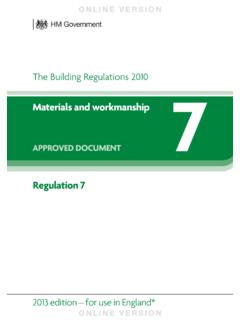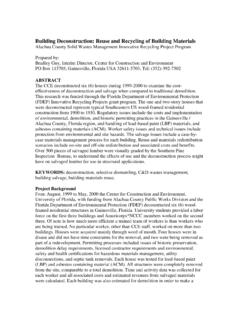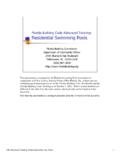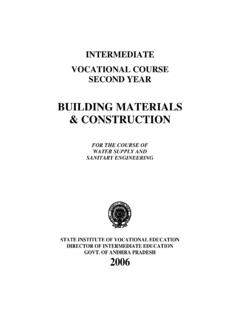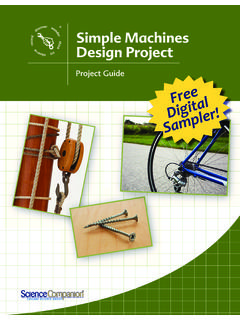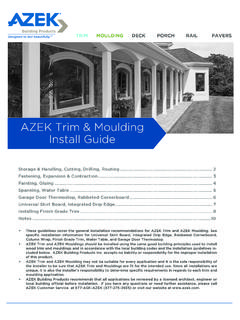Transcription of Construction dust CIS36 - Health and Safety Executive
1 1 of 6 pagesHealth and Safety ExecutiveHealth and Safety ExecutiveConstruction Information Sheet No 36 (Revision 2)HSE information sheetConstruction dustConstruction dust is not just a nuisance; it can seriously damage your Health and some types can eventually even kill. Regularly breathing these dusts over a long time can therefore cause life-changing lung diseases. This sheet tells employers what they need to know to prevent or adequately control Construction dust risks. It also provides advice for Safety representatives and dustThis is a general term used to describe different dusts that you may find on a Construction site. There are three main types: silica dust created when working on silica-containing materials like concrete, mortar and sandstone (also known as respirable crystalline silica or RCS); wood dust created when working on softwood, hardwood and wood-based products like MDF and plywood; lower toxicity dusts created when working on materials containing very little or no silica.
2 The most common include gypsum (eg in plasterboard), limestone, marble and dolomite. Health risksAnyone who breathes in these dusts should know the damage they can do to the lungs and airways. The main dust -related diseases affecting Construction workers are: lung cancer; silicosis; chronic obstructive pulmonary disease (COPD); lung disease, like advanced silicosis or asthma, can come on quite quickly. Figure 1 Common tasks like cutting can create very high dust levelsHowever, most of these diseases take a long time to develop. dust can build up in the lungs and harm them gradually over time. The effects are often not immediately obvious. Unfortunately, by the time it is noticed the total damage done may already be serious and life changing. It may mean permanent disability and early death. Construction workers have a high risk of developing these diseases because many common Construction tasks can create high dust levels.
3 Over 500 Construction workers are believed to die from exposure to silica dust every year. The amounts needed to cause this damage are not large. The largest amount of silica someone should be breathing in a day after using the right controls is shown below next to the 2 Your maximum daily silica exposure is tiny when compared to a penny2 of 6 pagesHealth and Safety ExecutiveThe law The Control of Substances Hazardous to Health Regulations 2002 (COSHH) cover activities which may expose workers to Construction dust . There are three key things you need to do: Assess (the risks) Control (the risks) Review (the controls)Assess (the risks)Assess the risks linked to the work and materials. Examples of high-risk tasks are listed in Table 1. High dust levels are caused by one or more of the following: task the more energy the work involves, the bigger the risk.
4 High-energy tools like cut-off saws, grinders and grit blasters produce a lot of dust in a very short time; work area the more enclosed a space, the more the dust will build up. However, do not assume that dust levels will be low when working outside with high-energy tools; time the longer the work takes the more dust there will be; frequency regularly doing the same work day after day increases the (the risks)Use the following measures to control the risk. Examples of controls for common high-risk tasks are given in Table or reduce the dust Before work starts, look at ways of stopping or reducing the amount of dust you might make. Use different materials, less powerful tools or other work methods. For example you could use: the right size of building materials so less cutting or preparation is needed; silica-free abrasives to reduce the risks when blasting; a less powerful tool eg a block splitter instead of a cut-off saw; a different method of work altogether eg a direct fastening the dust Even if you stop some dust this way, you may do other work that could still produce high dust levels.
5 In these cases the most important action is to stop the dust getting into the air. There are two main ways of doing this: Water water damps down dust clouds. However, it needs to be used correctly. This means enough water supplied at the right levels for the whole time that the work is being done. Just wetting the material beforehand does not 3 Water suppression on a cut-off saw On-tool extraction removes dust as it is being produced. It is a type of local exhaust ventilation (LEV) system that fits directly onto the tool. This system consists of several individual parts the tool, capturing hood, extraction unit and tubing. Use an extraction unit to the correct specification (ie H (High) M (Medium) or L (Low) Class filter unit). Don t just use a general commercial 4 Wall chasing using on-tool extraction3 of 6 pagesHealth and Safety ExecutiveRespiratory protective equipment (RPE) Water or on-tool extraction may not always be appropriate or they might not reduce exposure enough.
6 Often respiratory protection (RPE) has to be provided as well. You will need to make sure that the RPE is: adequate for the amount and type of dust RPE has an assigned protection factor (APF) which shows how much protection it gives the wearer. The general level for Construction dust is an APF of 20. This means the wearer only breathes one twentieth of the amount of dust in the air; suitable for the work disposable masks or half masks can become uncomfortable to wear for long periods. Powered RPE helps minimise this. Consider it when people are working for more than an hour without a break; compatible with other items of protective equipment; fits the user. Face fit testing is needed for tight-fitting masks; worn correctly. Anyone using tight-fitting masks also needs to be clean : RPE is the last line of protection.
7 If you are just relying on RPE you need to be able to justify your reasons for controlsDepending upon the work you are doing you may have to combine these measures with other controls. Think about: limiting the number of people near the work; rotating those doing the task; enclosing the work to stop dust escaping. Use sheeting or temporary screens; general mechanical ventilation to remove dusty air from the work area (eg in enclosed spaces such as indoors); selecting work clothes that do not keep hold of the also need to make sure workers are doing the job in the right way and are using controls properly. Train workers: about dust risks and how this can harm their Health ; how to use the dust controls and check that they are working; how to maintain and clean equipment; how to use and look after RPE and other personal protective equipment (PPE); what to do if something goes (the controls)You may already have the right controls in place, but are they all working properly?
8 Check the controls work by: having procedures to ensure that work is done in the right way; checking controls are effective. Does the work still seem dusty? You might need to carry out dust exposure monitoring; involving workers. They can help identify problems and find solutions; maintaining equipment: follow instructions in maintenance manuals; regularly look for signs of damage. Make repairs; replace disposable masks in line with manufacturer s recommendations; properly clean, store, and maintain non-disposable RPE. Change RPE filters as recommended by the supplier; carry out a thorough examination and test of any on-tool extraction system at least every 14 months. supervising workers. Make sure they: use the controls provided; follow the correct work method; attend any Health surveillance where it is may have to put a Health surveillance programme in place.
9 You may need advice for this from an occupational Health of 6 pagesHealth and Safety ExecutiveTable 1 Controls for common high-risk tasksTaskEliminate or limit the dust by:Control the dust by using:Cutting concrete kerbs, blocks and paving with a cut-off saw Limiting the number of cuts during design/layout Using lower energy equipment like block splitters Getting material cut off site and delivered Water suppression and RPE* with an APF of 20 Chasing concrete and raking mortar Limiting the need for chasing at the design/layout stage Using a work method that limits/does not need chasing, like over-covering cables On-tool extraction using an H or M Class extraction unit and RPE* with an APF of 20 consider powered RPE for longer duration workCutting roofing tiles with a cut-off saw Hand cutting natural/fibre cement slates and other tiles where possible Using and 1 tiles Correct setting out/design Minimising valleys/using dry valleys Water suppression and A dedicated cutting area with scaffold board protection and RPE* with an APF of 20 Scabbling or grinding with hand-held tools Specifying architectural finishes that do not need scabbling Using (ultra)
10 High-pressure water jetting Using chemical retarders and pressure washing Casting in proprietary joint formers, eg mesh formwork Where possible use on-tool extraction using an H or M Class extraction unit and RPE* with an APF of 20 Short-duration drilling totalling 15 30 minutes with hand-held rotary power tools Limiting the number of holes during design/planning Using direct fastening or screws Where possible use equipment that stops dust getting into the air. The larger the holes the better this needs to be. Options range from: drilling through a dust collector or using cordless extraction attached to the drill (for smaller drill bits) or on-tool extraction using an H or M Class extraction unit Otherwise use RPE* with an APF of 20 Drilling holes with hand-held rotary power tools as a main activity Limiting the number of holes during design/planning Using direct fastening or screws Where possible on-tool extraction using an H or M Class extraction unit and RPE* with an APF of 20 Dry coring Limiting the number of holes during design/planning On-tool extraction using an H or M Class extraction unit Longer duration work (ie over 15 30 minutes accumulated time over the day) will also need RPE.










